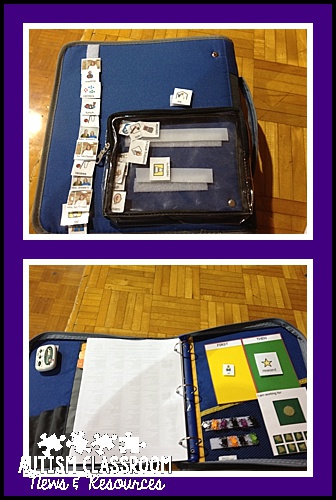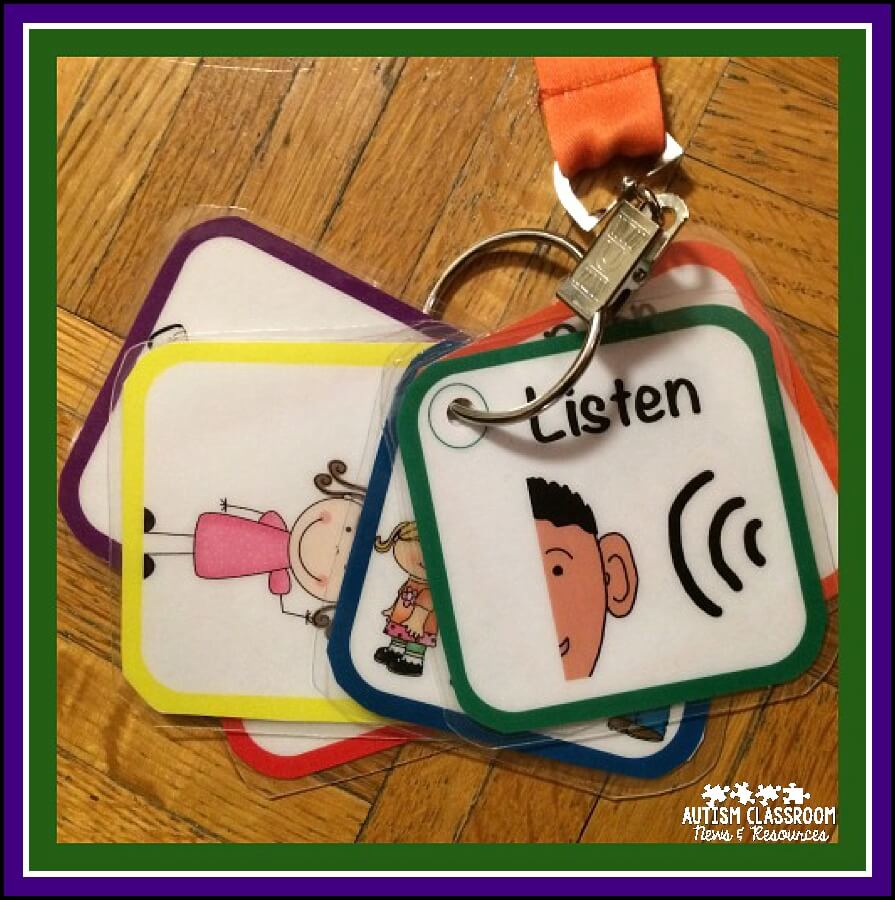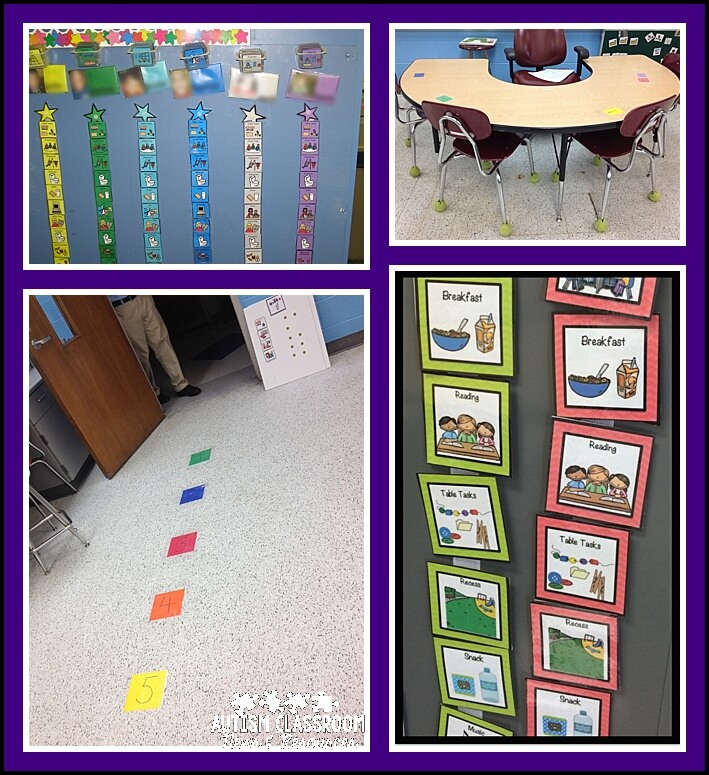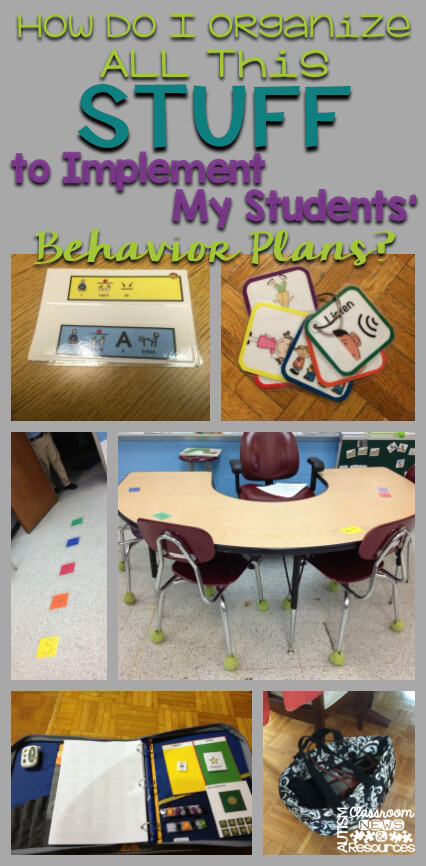One question that I get frequently when I consult to classrooms and by email is how to organize all the materials we need to implement a student’s behavior plan. Let’s face it, to use antecedent strategies effectively, to teach the skills that students need to replace challenging behaviors, and even to respond appropriately requires A LOT of stuff. Schedules, token boards, reinforcers, contingency maps, timers, visual cues for directions, picture communication and other AAC or visual reminders, social narratives, and on and on. These are all things we have to have at hand whenever they are needed, but without hauling around a rolling suitcase, here are some ideas about how to make sure you have what you need wherever you are.
This post contains affiliate links. This just means I receive a small commission if you buy something, but I only recommend things that I would use. You can see more in my disclosure policy.

Try putting the behavior plans in a Trapper Keeper (a notebook that zips–like in the picture) or in a clipboard that has a storage component likes those below. This makes it all more portable. Inside the Trapper Keeper are the student’s data sheets, his behavior plan, his token system and a timer Velcro’ed to the inside of the notebook. This keeps everything together wherever he goes around the school. Having a place for everything in the trapper keeper also makes it more likely it will get put back.
If the stuff is more 3-dimensional I use a bag. This is especially helpful if you have to carry around tangible reinforcers. I often use those bags you get when you go to a conference or professional development (cause I have millions hanging around my house–that’s not an exaggeration!). You could also use a shopping bag. I like bags that allow me to throw them over my shoulder to free up my hands. A checklist on the outside of the bag can be helpful too.
 Have students who need to take part of their schedule with them outside the classroom for specials or times in the general education classroom, but they aren’t independent enough to keep track of their own notebook schedule? A word of advice: Don’t start a whole class of students who aren’t independent in using their schedules on portable schedules at the same time because the will NEVER have their schedule when they need it. Start the most independent student first on a portable schedule. When he becomes independent, add another. In the meantime, have the students use schedules on the wall with portable cross bars that can travel with them like those above. Then they take the mini-schedule with them outside the room. They can then put the finished visuals on the back or on a check-in board the staff holds and returns to the classroom.
Have students who need to take part of their schedule with them outside the classroom for specials or times in the general education classroom, but they aren’t independent enough to keep track of their own notebook schedule? A word of advice: Don’t start a whole class of students who aren’t independent in using their schedules on portable schedules at the same time because the will NEVER have their schedule when they need it. Start the most independent student first on a portable schedule. When he becomes independent, add another. In the meantime, have the students use schedules on the wall with portable cross bars that can travel with them like those above. Then they take the mini-schedule with them outside the room. They can then put the finished visuals on the back or on a check-in board the staff holds and returns to the classroom.
 Most of our students have difficulty understanding verbal directions and we need to pair our words with visuals whenever possible. Some of them also need cues for language and need them everywhere they go. Put them on a lanyard. You can also put them on a stretchable belt and attach it to your belt loops of your pants if you have difficulty having them around your neck. Scripts and communication reminders can be carried the same way so you can pull them out and cue the student whenever and wherever needed.
Most of our students have difficulty understanding verbal directions and we need to pair our words with visuals whenever possible. Some of them also need cues for language and need them everywhere they go. Put them on a lanyard. You can also put them on a stretchable belt and attach it to your belt loops of your pants if you have difficulty having them around your neck. Scripts and communication reminders can be carried the same way so you can pull them out and cue the student whenever and wherever needed.
Make multiples of EVERYTHING–every visual, token system, token etc. and store them in a common place so that they are easy to grab on the fly. If you have a student (or 12) working on asking for attention, or waiting or asking for help or asking for a break or…ok you get the idea, I put those visuals EVERYWHERE the student goes is the room. For students who use pictures for communication, there is one Velcroed to every table or shelf so it’s easy to grab wherever they are. For students who are verbal but may need a visual cue, those can work for that as well. Your students travel outside the room? Add it to the binder above or put it on a lanyard for the student to wear if he needs to use it to communicate. If he just needs it as a cue for verbalizing, put it on a lanyard with your visual cues to have available to cue the student.

Color code for your students–each student has their own colored schedule (Sally-blue, Roger-Orange etc.), that color is also the color of the marker on their chair for their seat, the marker on the floor for morning meeting, notebook for data/behavior systems. This makes it easy to scan the room and find what you need quickly. There is nothing worse than getting to where you need to go and finding out you have someone else’s schedule, token board, etc.
So those are just some of the strategies I’ve used over the year to organize all the stuff we need for behavioral support.







